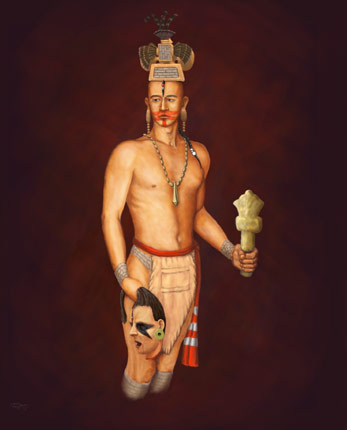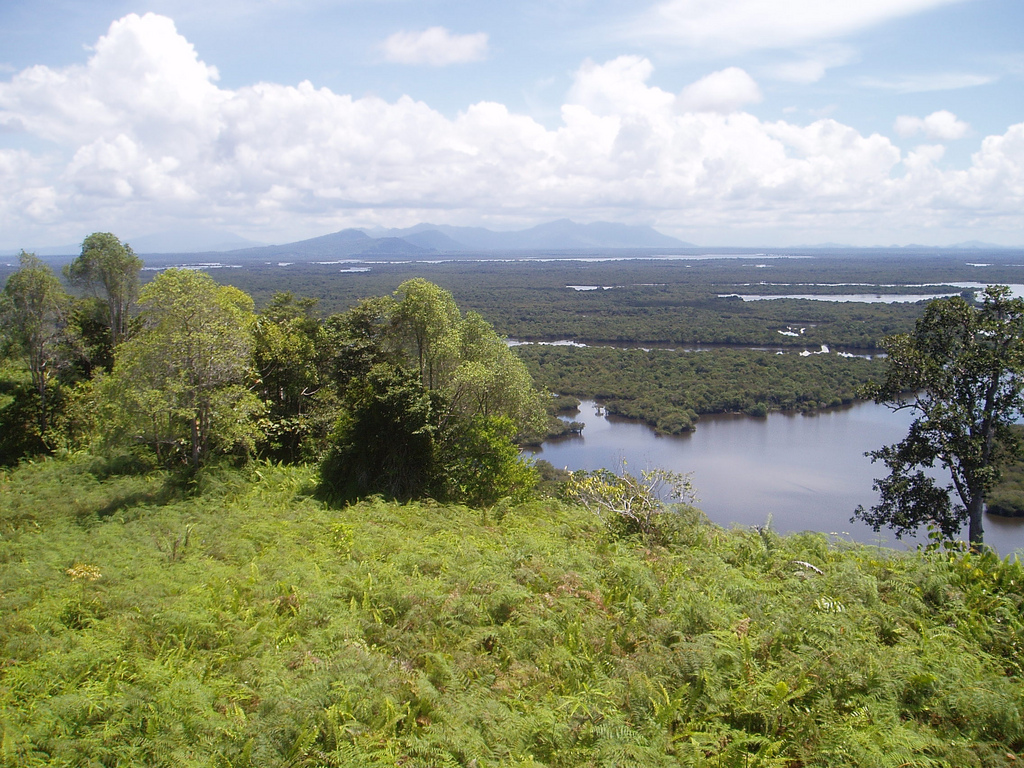|
Nyobeng
The Nyobeng/Nyobong is an ancient Dayak headhunting ritual that was performed to show gratitude for peace and good harvests. The ritual involved bathing or cleaning the skulls of sacrificed humans. The ceremony was performed by the Dayak Nyobeng Bidayu, Sebujit Hamlet, Village Hlibuei, Subdistrict Siding, Bengkayang and West Kalimantan, Indonesia. It was abandoned in 1894. Ceremony In the ceremony, humans were decapitated and their skulls preserved. It took place over a three-day period in June, led by elder Nyobeng Sebujit. As the guests arrived, the participants aimed their guns at the sky and fired a salute, intended as a sign of respect for their ancestors before starting the nyobeng. Guests were welcomed to show the bond between the village and people outside the village. Later, a local community leader would throw a puppu into the air as visitors attempted to slash it with swords as it fell, repeating the process if the animal reached the ground alive. The elder then repe ... [...More Info...] [...Related Items...] OR: [Wikipedia] [Google] [Baidu] |
Bidayuh
Bidayuh is the collective name for several indigenous groups found in southern Sarawak, Malaysia and northern West Kalimantan, Indonesia, on the island of Borneo, which are broadly similar in language and culture (see also #Language issues, issues below). The name ''Bidayuh'' means 'inhabitants of land'. Originally from the western part of Borneo, the collective name Land Dayak was first used during the period of Rajah James Brooke, the White Rajah of Sarawak. At times, they were also lesser referred to as Klemantan people. They constitute one of the main indigenous groups in Sarawak and West Kalimantan and live in towns and villages around Kuching and Serian Division, Serian in the Malaysian state of Sarawak, while in the Indonesian province of West Kalimantan they are mainly concentrated in the northern Sanggau Regency. In Sarawak, most of Bidayuh population can be found within 40 km of the geographical area known as Greater Kuching, within the Kuching Division, Kuching a ... [...More Info...] [...Related Items...] OR: [Wikipedia] [Google] [Baidu] |
Dayak People
The Dayak (; older spelling: Dajak) or Dyak or Dayuh are the native groups of Borneo. It is a loose term for over 200 riverine and hill-dwelling ethnic groups, located principally in the central and southern interior of Borneo, each with its own dialect, customs, laws, territory, and culture, although common distinguishing traits are readily identifiable. The Dayak were animist (Kaharingan and Folk Hindus) in belief; however, since the 19th century there has been mass conversion to Christianity and to Islam. Etymology It is commonly assumed that the name originates from the Bruneian and Melanau word for "interior people", without any reference to an exact ethnic group. Particularly, it derives from a related Kenyah word for "upstream" (compare with ethnonym Lun ''Dayeh''). The term was adopted by Dutch and German authors as an umbrella term for any non-Muslim natives of Borneo. Thus, historically, the difference between Dayak and non-Dayak natives could be understood as a ... [...More Info...] [...Related Items...] OR: [Wikipedia] [Google] [Baidu] |
Headhunting
Headhunting is the practice of hunting a human and collecting the severed head after killing the victim. More portable body parts (such as ear, nose, or scalp) can be taken as trophies, instead. Headhunting was practiced in historic times across parts of Europe, East Asia, Oceania, Southeast Asia, South Asia, Mesoamerica, South America, West Africa, and Central Africa. The headhunting practice has been the subject of intense study within the anthropological community, where scholars try to assess and interpret its social roles, functions, and motivations. Anthropological writings explore themes in headhunting that include mortification of the rival, ritual violence, cosmological balance, the display of manhood, cannibalism, dominance over the body and soul of his enemies in life and afterlife, as a trophy and proof of killing (achievement in hunting), show of greatness, prestige by taking on a rival's spirit and power, and as a means of securing the services of the vi ... [...More Info...] [...Related Items...] OR: [Wikipedia] [Google] [Baidu] |
Bengkayang
Bengkayang Regency () is a regency ("''kabupaten''") in West Kalimantan Province of Indonesia, (on the island of Borneo). The area was originally a part of Sambas Regency, but following the expansion of the population in that area, Sambas Regency was divided into a smaller Sambas Regency and a new Bengkayang Regency on 20 April 1999, and then Singkawang City was subsequently cut out of Bengkayang Regency on 21 June 2001. The regency now covers an area of 5,382.74 km2, and had a population of 215,277 at the 2010 CensusBiro Pusat Statistik, Jakarta, 2011. and 286,366 at the 2020 Census;Badan Pusat Statistik, Jakarta, 2021. the official estimate as at mid 2024 was 303,422 (comprising 157,364 males and 146,058 females).Badan Pusat Statistik, Jakarta, 28 February 2025, ''Kabupaten Bengkayang Dalam Angka 2025'' (Katalog-BPS 1102001.6107) The administrative centre is in the town of Bengkayang. Bengkayang is in northern West Kalimantan, sharing a border with Sarawak in Malaysia. With ... [...More Info...] [...Related Items...] OR: [Wikipedia] [Google] [Baidu] |
West Kalimantan
West Kalimantan () is a province of Indonesia. It is one of five Indonesian provinces comprising Kalimantan, the Indonesian part of the island of Borneo. Its capital and largest city is Pontianak. It is bordered by East Kalimantan and Central Kalimantan to the east, the Malaysian state of Sarawak to the north, and the Bangka Belitung Islands to the west and the Java Sea to the south. The province has an area of 147,037 km2, and had a population of 4,395,983 at the 2010 CensusBiro Pusat Statistik, Jakarta, 2011. and 5,414,390 at the 2020 Census;Badan Pusat Statistik, Jakarta, 2021. the official estimate as at mid 2023 was 5,623,328 (comprising 2,887,209 males and 2,736,119 females), and was projected to rise to 5,695,500 at mid 2024.Badan Pusat Statistik, Jakarta, 28 February 2024, ''Provinsi Kalimantan Barat Dalam Angka 2024'' (Katalog-BPS 1102001.61) Ethnic groups include the Dayak, Malay, Chinese, Javanese, Bugis, and Madurese. The borders of West Kalimantan roughl ... [...More Info...] [...Related Items...] OR: [Wikipedia] [Google] [Baidu] |
Indonesia
Indonesia, officially the Republic of Indonesia, is a country in Southeast Asia and Oceania, between the Indian Ocean, Indian and Pacific Ocean, Pacific oceans. Comprising over List of islands of Indonesia, 17,000 islands, including Sumatra, Java, Sulawesi, and parts of Borneo and New Guinea, Indonesia is the world's largest archipelagic state and the List of countries and dependencies by area, 14th-largest country by area, at . With over 280 million people, Indonesia is the world's List of countries and dependencies by population, fourth-most-populous country and the most populous Islam by country, Muslim-majority country. Java, the world's List of islands by population, most populous island, is home to more than half of the country's population. Indonesia operates as a Presidential system, presidential republic with an elected People's Consultative Assembly, legislature and consists of Provinces of Indonesia, 38 provinces, nine of which have Autonomous administrative divisi ... [...More Info...] [...Related Items...] OR: [Wikipedia] [Google] [Baidu] |
Boar
The wild boar (''Sus scrofa''), also known as the wild swine, common wild pig, Eurasian wild pig, or simply wild pig, is a Suidae, suid native to much of Eurasia and North Africa, and has been introduced to the Americas and Oceania. The species is now one of the widest-ranging mammals in the world, as well as the most widespread Suina, suiform. It has been assessed as least concern on the IUCN Red List due to its wide range, high numbers, and adaptability to a diversity of habitats. It has become an invasive species in part of its introduced range. Wild boars probably originated in Southeast Asia during the Early Pleistocene and outcompeted other suid species as they spread throughout the Old World. , up to 16 subspecies are recognized, which are divided into four regional groupings based on skull height and lacrimal bone length. The species lives in matriarchal societies consisting of interrelated females and their young (both male and female). Fully grown males are usually s ... [...More Info...] [...Related Items...] OR: [Wikipedia] [Google] [Baidu] |
Headhunting
Headhunting is the practice of hunting a human and collecting the severed head after killing the victim. More portable body parts (such as ear, nose, or scalp) can be taken as trophies, instead. Headhunting was practiced in historic times across parts of Europe, East Asia, Oceania, Southeast Asia, South Asia, Mesoamerica, South America, West Africa, and Central Africa. The headhunting practice has been the subject of intense study within the anthropological community, where scholars try to assess and interpret its social roles, functions, and motivations. Anthropological writings explore themes in headhunting that include mortification of the rival, ritual violence, cosmological balance, the display of manhood, cannibalism, dominance over the body and soul of his enemies in life and afterlife, as a trophy and proof of killing (achievement in hunting), show of greatness, prestige by taking on a rival's spirit and power, and as a means of securing the services of the vi ... [...More Info...] [...Related Items...] OR: [Wikipedia] [Google] [Baidu] |


